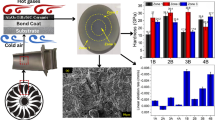Abstract
Ceramic matrix composites have been identified as a potential material of core structure for the fourth generation of fission nuclear reactors. Regarding their excellent mechanical behavior in very harsh conditions (high temperature and high irradiation flux), the CVI–SiCf/SiC composites with pyrocarbon interlayer are of prime interest for the fuel cladding in the gas-cooled fast reactor. Although the working atmosphere is helium in these advanced reactors, the presence of oxidizing impurities could have a significant role on the mechanical behavior of materials subjected to long-term exposures. Within this framework, this study was intended to investigate the influence of oxidation on the SiCf/SiC composites mechanical properties. Different pre-damage states were intentionally introduced by mechanical tensile tests on plate specimens before performing an oxidation treatment of 1,000 h at 1,000 °C under helium with 10 ppm of O2. The degradation of the composite was determined from the mechanical behavior of post-exposure specimens. Results were correlated both with microstructural observations of the damage and with characterizations of the generated oxides at the surface of the composites. The most severe decline of mechanical properties occurs for the higher predamaged loadings. Indeed in this case, the silica formed during the oxidation of SiC is not in sufficient quantities to fill the cracks.









Similar content being viewed by others
References
Y. Katoh, T. Nozawa, L. L. Snead, K. Ozawa, and H. Tanigawa, Journal of Nuclear Materials 417, 400 (2011).
L. L. Snead, T. Nozawa, Y. Katoh, T. S. Byun, S. Kondo, and D. A. Petti, Journal of Nuclear Materials 371, 329 (2007).
C. Lorrette, C. Sauder, and L. Chaffron, 18th International Conference on Composite Materials, Conference Proceeding, (Jeju Island, 2011).
E. Buet, C. Sauder, S. Poissonnet, P. Brender, R. Gadiou, and C. Vix-Guterl, Journal of the European Ceramic Society 32, 547 (2012).
L. Filipuzzi, and R. Naslain, Journal of the American Ceramic Society 77, 467 (1994).
J. Eck, M. Balat-Pichelin, L. Charpentier, E. Bêche, and F. Audubert, Journal of the European Ceramic Society 28, 2995 (2008).
J. Lamon, F. Rebillat, and A. Evans, Journal of the American Ceramic Society 78, 401 (1995).
C. Chateau, L. Gelebart, M. Bornert, J. Crépin, E. Boller, C. Sauder, and W. Ludwig, Composites Science and Technology 71, 916 (2011).
Acknowledgments
This work has been supported by CEA through a training course grant to E. Torres. The authors are grateful to M. Lahaye for the AES analyses, C. Labrugere for the XPS analyses and B. Duprey for the oxidation tests.
Author information
Authors and Affiliations
Corresponding author
Rights and permissions
About this article
Cite this article
Torres, E., Lorrette, C., Weisbecker, P. et al. Influence of an O2 Type Oxidizing Environment on SiCf/SiC Composites: Properties/Microstructure Relationship. Oxid Met 80, 267–277 (2013). https://doi.org/10.1007/s11085-013-9384-0
Received:
Published:
Issue Date:
DOI: https://doi.org/10.1007/s11085-013-9384-0




